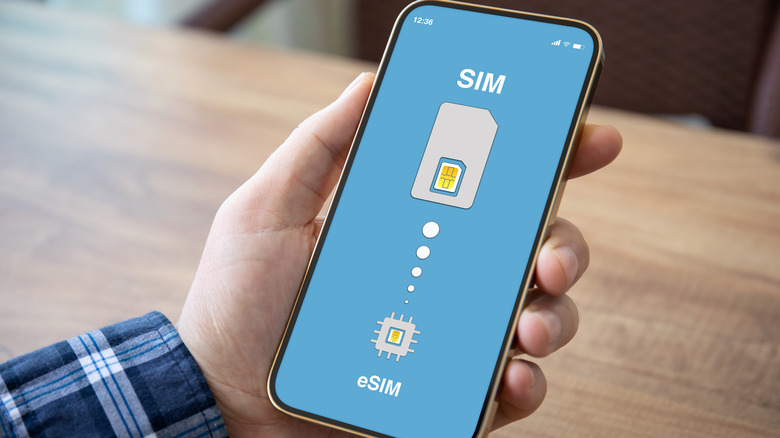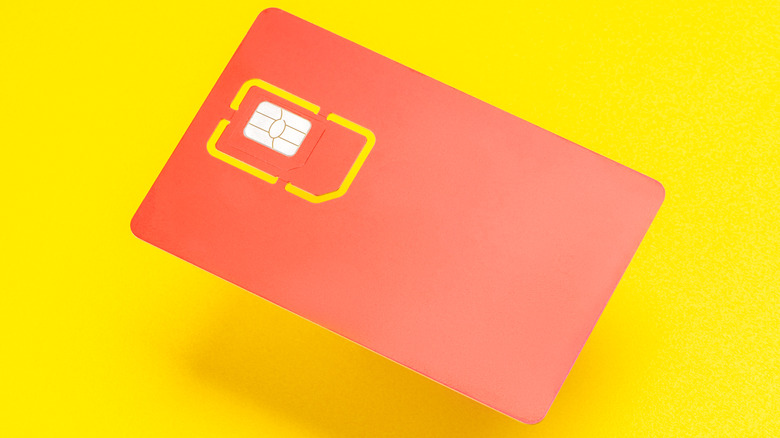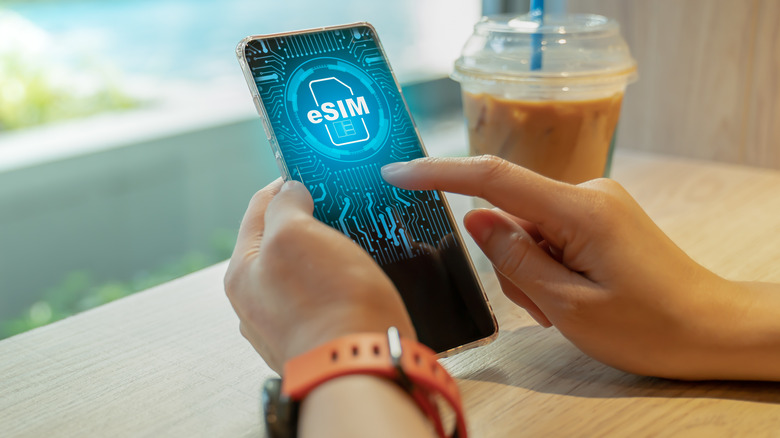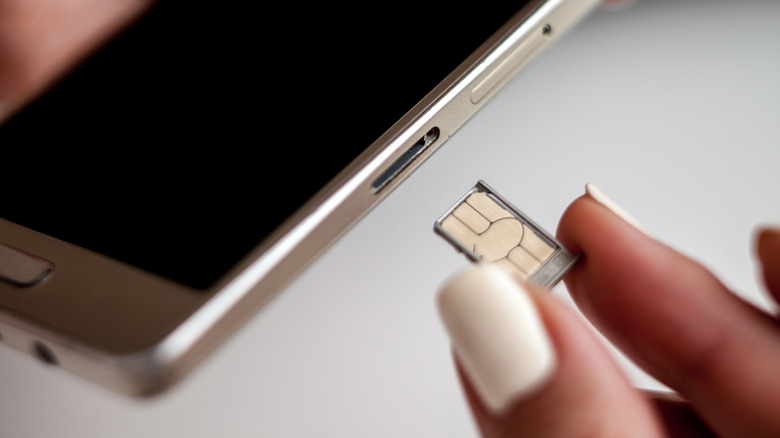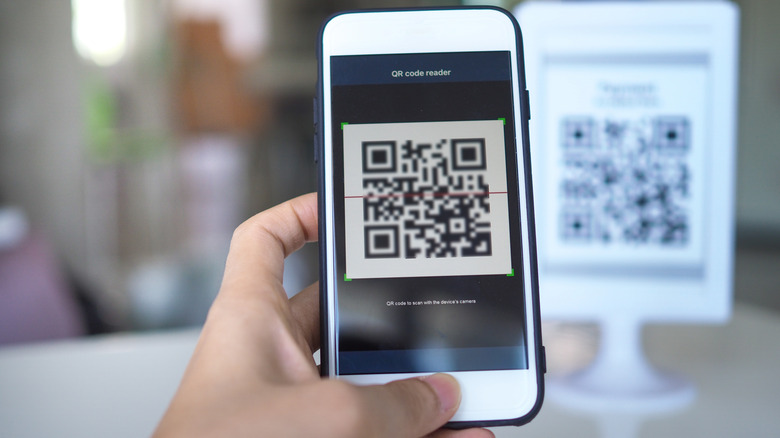What Is eSIM And How Do You Use It?
Over the years, Apple has hit the headlines for declaring something obsolete and taking it away almost as often as it has for adding parts. The most famous and contentious example is the tech company's decision to drop the headphone jack from the iPhone 7. While many people disagreed with that choice and still like the option of using wired headphones with a standardized connector, the industry itself began to follow suit. Samsung, Apple's biggest rival, dropped the jack from its flagship phones a few years afterward. Apple has also been rumored to be getting rid of the charging port at some point in the future. Noted analyst Ming-Chi Kuo suspects the company will make the move, and it could be for waterproofing reasons or just a way to avoid being forced to use USB-C.
So what is Apple dropping this time? If rumors are to be believed, then SIM cards could be on the way out. SIM cards are small chips that phone companies send out which allow a phone or tablet to connect to their network. SIM cards have been in use for decades, though they have gotten smaller over the years. Most modern phones use a nano-SIM, which is only slightly bigger than the chip itself. They tend to be shipped out as full-sized cards that can be adjusted to the correct size. But even the nano-SIM could be more trouble than it's worth, and there is a clear alternative.
What is an eSIM?
An embedded SIM, or eSIM, is an electronic version of a SIM card that is built into the phone itself. A regular SIM card only contains a small amount of information, basically a code the network uses to identify you. An eSIM works by allowing your phone to write that code onto it. The chip can be rewritten as many times as it needs to be, so there's no messing around swapping out pieces of plastic every time you switch carriers.
Although it isn't quite as old as the physical SIM card, the eSIM has been around for a while; it was first introduced in 2012 and drew a fair amount of interest from the automotive industry (via Giesecke+Devrient). Communications and cars have been linked for a while, from the CB radios of the '70s to clunky 1980s car phones — so, naturally, an easier way to get connected would appeal to automakers. These days, eSIMs can be found in a wide range of vehicles.
Apple's devices have had eSIMs installed for a while now — going back to the iPhone XS and including newer iPad Pros. While it's been an option up until now, making it the only choice could still be seen as a bold move. The eSIM has positives as well as negatives.
What are the benefits of eSIM?
There are some obvious benefits to eSIM. Firstly, nothing physical has to be mailed out by your wireless service provider and you don't have to go to a store to pick your eSIM up. Everything is done online, and you can start using your new plan seconds after signing up for it. Multiple carrier plans can be loaded onto the eSIM, so if you have more than one phone plan, such as a personal line and one for work, you only need one device.
Free trials will also be easier to use; you can get access to a plan instantly, try it out, and switch just as easily if it isn't for you. You could even try out a new network while still using your current plan on the same device. The same plan can also be loaded onto several eSIMs, so if you have a plan that covers your phone, iPad, and car, you won't have to mess around installing physical SIM cards in all of them.
An eSIM uses up less space than a physical SIM, so phones can either get smaller or potentially use that room for other components — there is also one less hole in the phone that needs waterproofing. Finally, you don't need to search for that small spike that comes with your phone or unfurl a paperclip every time you need to do something with the SIM card, as explained by US Mobile.
The downsides of an eSIM
eSIMs are a great innovation and more than likely the future. Even if Apple doesn't go eSIM-only, more and more manufacturers are likely to add the feature to their devices in the near future. As with anything, there are a couple of negatives. Firstly, the eSIM chip has to actually be built into the phone; it isn't something you can add later, so budget phones are unlikely to have eSIMs installed.
As the eSIM is built into the phone, you can't take it out and put it into another phone like you can with a regular SIM card. This might not be much of an issue, though. There are only a few scenarios where you'd be moving a SIM card between phones. If you're worried about being tracked, you won't be able to easily yank the SIM card out of your phone anymore, either.
Another negative involves your wireless service provider — not all networks currently support eSIM technology, so that's something else you'll have to check before you pull the trigger on a plan. Service providers also love slapping fees on things, and an activation fee every time you want to switch your eSIM across to another phone seems like a scenario that could happen. eSIMs are currently free to set up with all of the major carriers that support the technology, though this could change in coming years if they get more popular.
How to set up an eSIM
As US Mobile explains, setting up an eSIM is far simpler than setting up a regular SIM. Once you've found a carrier that supports eSIM technology, select the plan that suits you. The carrier will then display a voucher with a QR code that you scan with your phone's camera. The QR code gives your phone the information it needs and activates the plan. Your plan's SIM profile is then recorded on the eSIM and you are free to get on with your day.
Adding additional carriers follows the same process. You can select from the carriers you have installed on your eSIM by going to the network area of your phone's settings menu. The only time you'll run into issues when adding extra plans is if the phone you've bought is locked to a single provider, which is typically the case if you're paying for the device in monthly installments. All of this is definitely simpler than checking the mail daily or wasting time looking for paper clips and swapping out SIM cards.
